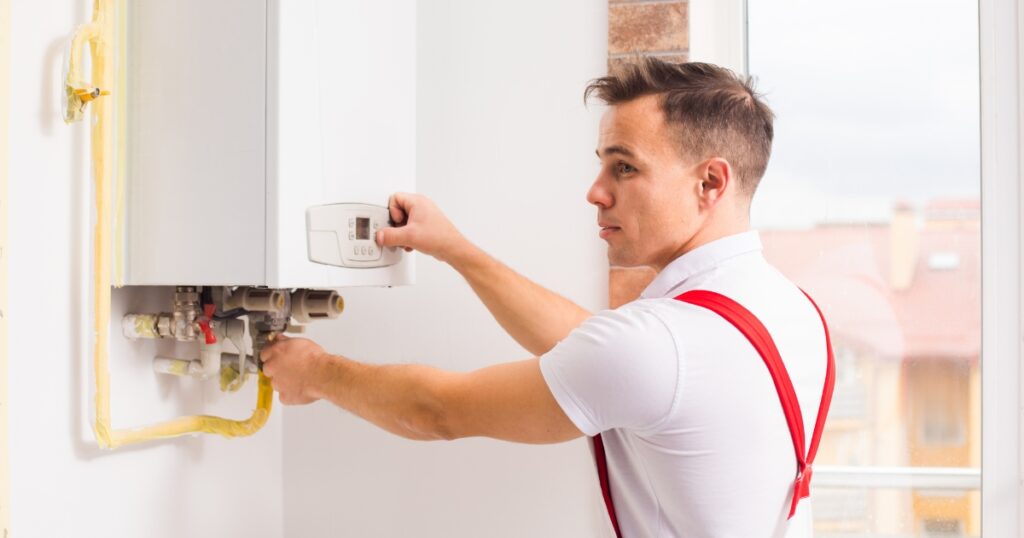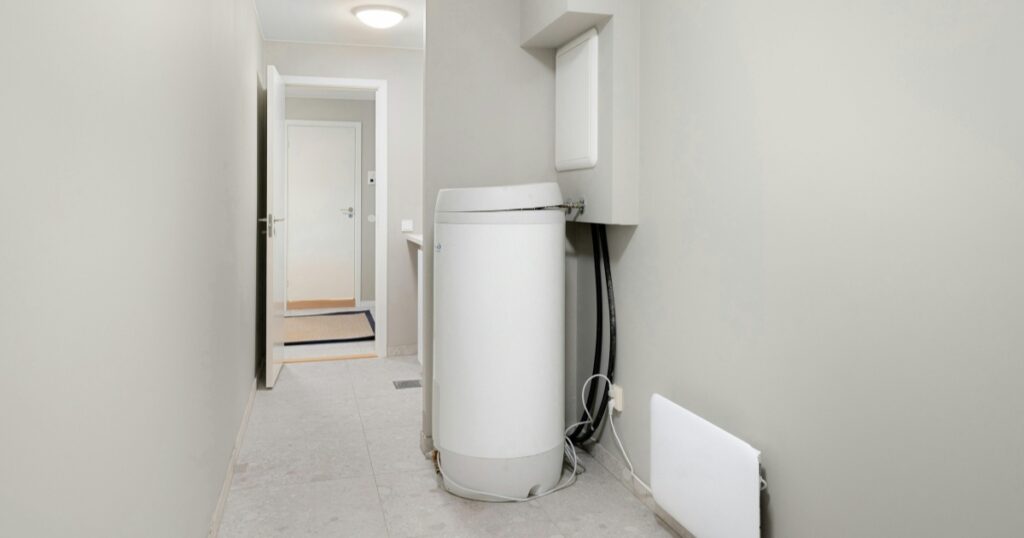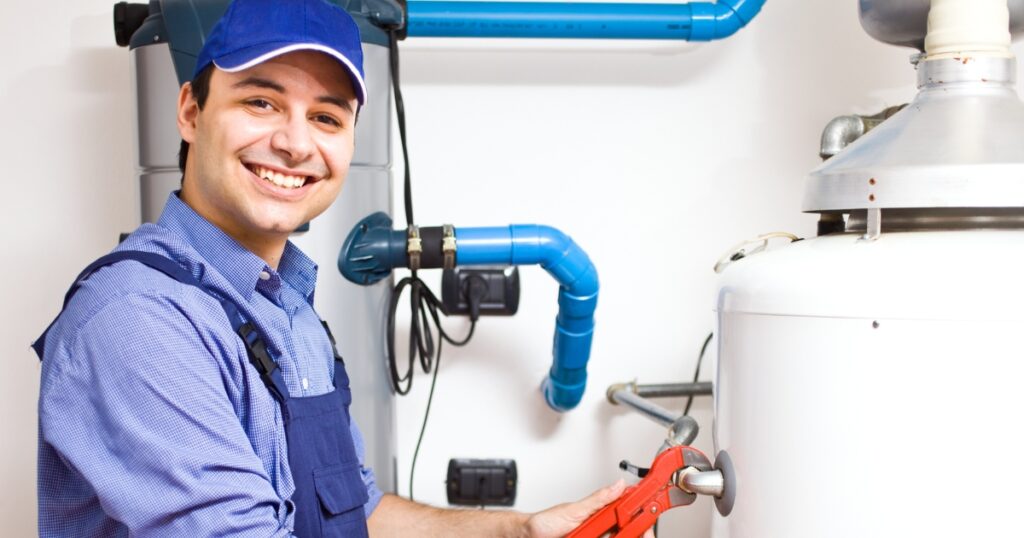Ah, the old icy blast instead of a cosy warm hug from your shower – it’s nearly an Aussie rite of passage, isn’t it? Whether you’re in Brissie or down in Tassie, that moment when you cop a cold spray can startle your senses.
And wouldn’t you know it, about 65% of us Down Under cop hot water hassles every year? But not to worry, we’ve done our homework and found some top-notch tips that’ll have you enjoying piping-hot showers again quicker than you can say “She’ll be right.” So hang tight – we’re about to make those shivery showers a thing of the past!
Key Takeaways
- Regular maintenance, like flushing the tank and checking valves, prevents water heater issues and saves on future costs.
- Upgrading to a modern system or adding a PTRV increases the safety and efficiency of your hot water supply.
- Fixing mineral buildup with routine cleans protects your system from damage and keeps it running smoothly.
- Insulating pipes and using smart thermostats can manage temperature fluctuations for consistent hot comfort.
- Call a professional when faced with no hot water, discoloured water, or blocked exhaust to avoid bigger issues.
Common Hot Water System Issues
Leaking, cold or overly hot water, no water, and noisy systems are all common problems that homeowners might encounter with their water heaters. These issues can disrupt daily routines and cause frustration, but there are innovative solutions to address them effectively.

Leaks
Leaks in your hot water system can cause a real headache. They often sneak up on us, dripping quietly until the issue becomes impossible to ignore. We’ve all been there, spotting a pool of water under the hot water unit and feeling that pang of frustration.
These leaks might come from valves, connections or even tiny cracks in the tank itself; no matter their origin, they demand swift attention before causing more damage.
Spotting a leak early is key to preventing a minor problem from becoming a full-blown disaster. It’s about keeping an eye out for wet spots around your heater or checking for drips when you hear an unusual hissing sound.
Tackling these issues straight away leads to less stress and prevents higher costs down the line. Now let’s turn our focus to another common challenge – managing cold or overly hot water from our taps.
Cold or overly hot water
If your hot water system is producing water that’s either too cold or scalding hot, the issue may be with the thermostat. To fix this, check to see if there are any adjustments you can make to the unit itself.
If not, call a professional to recalibrate or replace the thermostat. Another common cause of temperature irregularities could be sediment buildup in your tank. Flushing out the tank regularly as part of your maintenance routine will help prevent this problem from occurring.
No water
If your hot water system isn’t producing any water, check if the pilot light is on for a gas system or if the circuit breaker hasn’t tripped for an electric one. If these are not the issues, then it might be time to call a professional plumber to inspect and repair the unit.
Remember that attempting repairs on your own can cause further damage and may void any warranty you have. Seeking professional repair services will ensure that your hot water unit issues are diagnosed and fixed correctly, restoring warm water to your home promptly.
In addition, addressing ‘no water’ problems promptly can help prevent further inconvenience and potential damage to your plumbing system. Taking quick action when facing no hot water ensures that you won’t have disruptions in your daily routines due to cold showers or the inability to use essential appliances like dishwashers and washing machines efficiently.
Noisy system
If your hot water system was making strange noises, it could be a sign of mineral buildup, which can cause banging or rumbling sounds. This buildup occurs over time in the tank and may need to be flushed out by a professional plumber.
Alternatively, the noise might also indicate that the heating element is burning out, which will require replacing. In either case, addressing the issue promptly can prevent further damage and ensure your hot water system operates quietly and efficiently.
Installing a pressure and temperature relief valve (PTRV) can also help reduce noisy operation by preventing excessive pressure within the tank. Regular maintenance and cleaning of the system’s components such as burner assemblies or heating elements are essential to keeping everything running smoothly and quietly.
Innovative Solutions for Hot Water Service Problems
We’ll explore how proper maintenance, upgrading to a newer system, installing a pressure and temperature relief valve (PTRV), removing mineral buildup, and addressing cold starts or temperature fluctuations can solve your hot water service problems.
Proper maintenance
Proper maintenance is crucial for preventing hot water system issues. Regularly inspect the system for leaks, corrosion, or wear and tear. Flush the tank to remove sediment buildup, and check the pressure relief valve for proper operation. Test the temperature and pressure settings annually. Additionally, consider insulating your pipes and heater to improve efficiency. Finally, schedule professional servicing every year to ensure optimal performance and longevity of your hot water system.
Upgrading to a newer system
If you find that your hot water system is no longer efficient or reliable, upgrading to a newer model could be the best long-term solution. Newer systems are designed with improved energy efficiency, better temperature control, and advanced features that can provide consistent and reliable hot water throughout your home.
Upgrading to a newer gas or electric hot water system can not only improve the performance of your water heater but also save you money in the long run by reducing energy consumption and maintenance needs.
Installing a pressure and temperature relief valve (PTRV)
After considering upgrading to a newer system, another innovative solution for addressing hot water service problems is installing a pressure and temperature relief valve (PTRV). This valve helps regulate the pressure and temperature inside the hot water tank, preventing the risk of dangerous build-up. Here are some crucial steps to consider when installing a PTRV:
- Start by turning off the power supply and cold-water inlet to the hot water system.
- Locate the PTRV port on the hot water tank and carefully remove any insulation covering it.
- Use a spanner to unscrew the old PTRV, paying close attention to any residual pressure or heat that may be trapped inside.
- Replace the old valve with a new PTRV of matching size and specifications.
- Securely fasten the new valve in place using appropriate fittings and make sure it is tightly sealed.
- Once installed, test the new PTRV by slowly reopening the cold-water inlet and observing for any leaks or irregularities.
Removing mineral buildup
To ensure the efficient functioning of your hot water system, it’s crucial to address mineral buildup. This can be achieved by:
- Flushing the Tank: Draining and flushing the hot water tank to remove sediment and mineral deposits that have settled at the bottom.
- Installing a Water Softener: Utilising a water softener to reduce the hardness of water, preventing mineral buildup in the system.
- Regular Maintenance: Implementing routine professional maintenance to clean and descale the heating elements and internal components.
- Using Vinegar Solution: Employing a vinegar solution to dissolve mineral buildup within the tank, followed by flushing out the loosened deposits.
- Considering Filtration Systems: Investing in filtration systems designed to capture and remove minerals before they enter the hot water system.
- Adjusting Temperature Settings: Lowering the temperature setting on your water heater to reduce mineral precipitation within the tank.
Addressing cold starts or temperature fluctuations
To ensure your hot water system operates smoothly, consider addressing cold starts or temperature fluctuations. Here are some innovative solutions to help you troubleshoot and resolve these issues:
- Check the thermostat settings to ensure they are accurate and suitable for your household’s needs.
- Insulate your hot water pipes to prevent heat loss and maintain consistent water temperature.
- Install a timer or smart thermostat to regulate the heating cycles and reduce energy consumption.
- Consider upgrading to a tankless hot water system for on-demand heating and precise temperature control.
- Have a professional plumber inspect the system for any mechanical issues that may be causing temperature fluctuations.

When to Call a Plumber for Hot Water Heater Issues
If you notice no hot water, discoloured or smelly water, or a blocked exhaust from your hot water system, it’s time to call a plumber. Read more for tips on when to seek professional help with your water heater issues.
No hot water
If your hot water system is failing to produce any hot water, it could be due to a faulty heating element. Check the thermostat settings to ensure they are correctly adjusted and that the power supply is working correctly.
You can also test the heating element for continuity using a multimeter. If you’re not comfortable doing this, contact a qualified plumber who can diagnose and fix the issue promptly.
Discoloured or smelly water
If you notice discoloured or smelly water coming from your hot water system, it could be a sign of sediment buildup or bacterial growth. To address this issue, consider flushing out your hot water tank to remove any accumulated sediments that can cause discolouration and unpleasant odours.
Another solution is installing a water filtration system to improve the quality of the water coming from your water heater, thus eliminating any odour or discolouration.
Additionally, regular professional maintenance by a licensed plumber can help prevent the buildup of contaminants in your hot water tank, ensuring that you have clean and odour-free hot water for everyday use.
Blocked exhaust
If you notice a blocked exhaust in your gas hot water system, it could be due to debris or sediment buildup. This can lead to improper ventilation and potential safety hazards. It’s important to address this issue promptly by checking for any obstructions and clearing them carefully.
Blocked exhaust can cause the heater to malfunction or even release dangerous carbon monoxide into your home, so it’s crucial to get professional assistance if you’re unsure how to handle this situation.
Regular inspection of the exhaust vent is essential as part of preventive maintenance for your hot water system. Keeping the exhaust clear ensures that your gas water heater operates efficiently and safely, providing you with reliable hot water when needed.
Address Your Water Heater Problems
After exploring innovative solutions for common water heater service problems, it’s clear that proper maintenance can prevent many issues. Upgrading to a newer system or installing a pressure and temperature relief valve are effective proactive measures.
Removing mineral buildup addresses one of the most common causes of decreased performance. Addressing cold starts or temperature fluctuations ensures consistent hot water flow. These cutting-edge techniques offer practical ways to maintain a reliable hot water supply.






